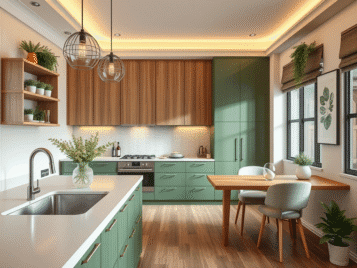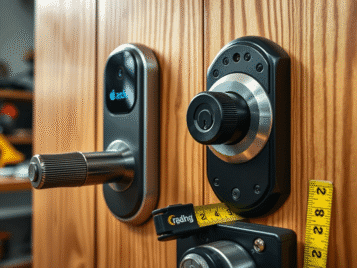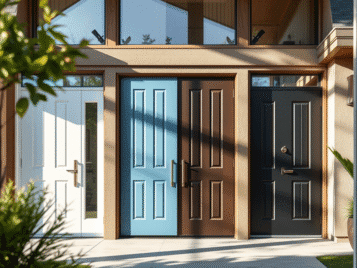You bought certified plywood—maybe even paid a premium for SamratHPL’s E0, boil‑proof sheets—but the job site can undo that investment in a week. Sun‑baked stacks curl at the edges, damp floors seed mould, and hurried labourers drag boards that arrive pristine but leave gouged. Proper storage isn’t glamorous, yet it’s cheaper than replacing warped sheets or sanding out cup‑shaped panels that never sit flush.
This guide distills best practices from sweaty monsoon sites in Mumbai to frost‑bitten projects in Oslo. Follow these steps and your plywood will stay as flat and stable as the day it left the factory.
1. Build a Raised, Level Platform
- Height: Minimum 150 mm off the floor—higher if water can pool.
- Material: Use scrap 50 × 75 mm timber sleepers or steel box sections.
- Spacing: Sleepers no more than 400 mm apart to prevent sag.
Why it matters
Ground moisture is plywood’s silent enemy; a cool concrete slab can wick vapor straight into the core. Raising the stack ensures airflow and keeps edges clean.
2. Stack Boards Face‑to‑Face, Back‑to‑Back
Alternate each sheet’s factory face and back as you stack. The opposing veneer stresses counteract each other, reducing “smiley” or “frowny” warp.
- Align corners perfectly; staggered edges invite chips.
- Use stickers—3 mm spacers every 600 mm—if boards arrive slightly damp. This promotes even drying.
3. Cover—But Let It Breathe
- Top cover: A waterproof tarpaulin or plastic sheet.
- Sides: Leave 150 mm gap at the bottom for cross ventilation.
- Colour note: Use light‑coloured tarps in hot regions; dark colours act like solar ovens.
Bonus tip: Slit small vents in the tarp’s lowest corners so trapped warm air can escape without letting rain in.
4. Monitor Moisture Weekly
A ₹1 500 (or €15) handheld moisture meter pays for itself fast.
| Climate zone | Acceptable range | Action |
|---|---|---|
| Humid tropics | 12–15 % | Sticker stack with fans for 48 h |
| Temperate | 8–12 % | Store as is |
| Arid | 6–10 % | Mist lightly if < 6 % to avoid brittle edges |
High readings? Separate boards with 25 mm battens and run an industrial fan. Low readings? Cover tighter; overly dry plywood can crack when cut.
5. Rotate the Stack Every 10 Days
Lift and flip the top half onto a new pallet. Gravity‑driven compression evens out minor warp, especially on long projects where stock sits for weeks.
- Crew size: Four workers for 8 × 4 ft sheets; always grip along the long edge, not the ends.
- Glove rule: Use nitrile or cloth gloves—greasy fingerprints attract dust and stain veneers.
6. Label and Date Your Piles
Marker the delivery date and grade on cardboard tags taped to the stack. First‑in, first‑out prevents old stock hiding under fresh deliveries—vital on multi‑phase builds where interior work starts months after structure work.
7. Protect Edges During Handling
- No dragging: Lift, then carry.
- Edge guards: Re‑use corner protectors from pallet crates; slide them onto sheet corners before transporting to the cutting table.
- Short lifts: Use panel carriers or vacuum grips for single‑person moves.
8. Site‑Specific Tweaks
| Condition | Adaptation |
|---|---|
| Coastal salt air | Wipe edges weekly with a damp, clean cloth to remove salt crystals that attract moisture. |
| Freezing winters | Warm indoor storage overnight (10–15 °C) before machining; frozen veneers splinter easily. |
| Desert heat | Rotate tarps at midday; underside condensation can surprise you when night temps plunge. |
9. What About Off‑Cuts?
Small pieces warp fastest. Immediately:
- Stack and clamp off‑cuts between two scrap boards.
- Sticker if damp.
- Use within 72 hours for drawer backs, nailers, or blocking.
10. Quick‑Reference Checklist
- Raised platform installed
- Boards stacked face‑to‑face, back‑to‑back
- Ventilated waterproof cover secured
- Moisture logged weekly
- Stack rotated bi‑weekly
- Edge guards used during moves
- Off‑cuts clamped or used quickly
Final Word
It takes one hour to set up a proper plywood storage bay and seconds to teach your site crew the routine. In return, you sidestep warped cabinet doors, bubbling laminates, and replacement orders that wreck schedules. Store smart, and your SamratHPL sheets will perform exactly as engineered—strong, stable, and ready to shine in the finished space, no matter where in the world that space happens to be.



